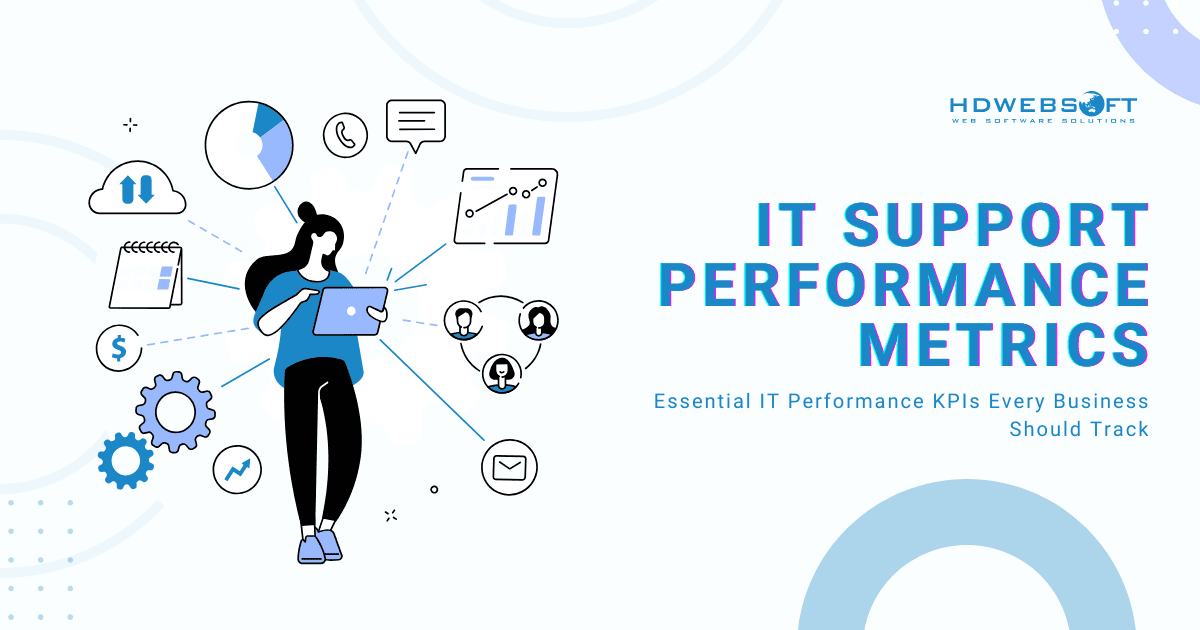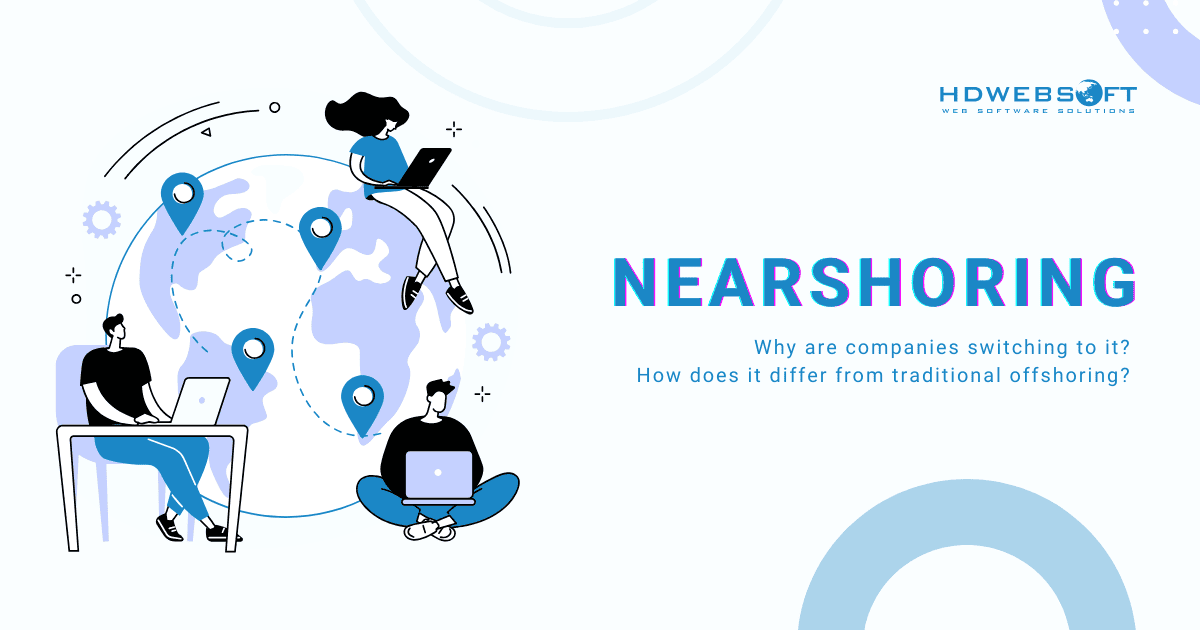
An Overview of The Hidden IT Support Costs
When your server crashes at 2 PM on a busy Tuesday, calculating the immediate IT support costs seems straightforward. However, recent data reveals a startling truth that’s forcing business leaders to reconsider their entire approach to technology management. IT outages now cost $14,056 per minute on average. Yet, most organizations only account for direct repair expenses while ignoring the cascading financial impact that can multiply actual costs.
Furthermore, the digital transformation accelerated by recent global events has fundamentally changed how businesses operate. Companies now depend on technology infrastructure more than ever before. They’re increasingly turning to professional software outsourcing services and IT outstaffing solutions to optimize their technology support while controlling costs. Hence, economic pressures and heightened customer expectations are compelling organizations to scrutinize every dollar spent on technology support.
Consequently, businesses are discovering that upgrading their approach to IT support outsourcing isn’t merely a technical decision. Let’s explore this strategic investment with measurable returns that can determine competitive advantage in an increasingly digital marketplace.
- 1) Understanding Hidden IT Support Costs Beyond the Obvious Numbers
- 2) How Poor IT Support Costs Impact Customer Experience
- 3) Optimizing Business IT Strategy with Modern Support Models
- 4) Calculating IT Support ROI: The Business Case for Investment
- 5) Reducing IT Downtime Costs Through Strategic Planning
- 6) Conclusion
IT support costs extend far beyond the visible expenses that appear on monthly invoices. While most organizations focus on hourly rates and service contracts, the real financial impact of poor IT support creates a devastating ripple effect throughout the entire business ecosystem.
Direct Financial Impact That Hits Immediately
First and foremost, revenue loss occurs instantly when critical systems fail. E-commerce platforms lose sales with every minute of downtime, SaaS companies face immediate customer dissatisfaction, and financial services risk regulatory penalties. Recent surveys show that small and medium-sized businesses report their cost of downtime as $300,000 or more per hour. As you can see, the statistics have demonstrated how quickly IT downtime costs can escalate.
Additionally, productivity calculations reveal staggering numbers when examined closely. For a company with 50 employees, one hour of downtime costs $2,076.50 in lost productivity alone. This figure has increased significantly from previous years, due to rising compensation as hidden IT support costs and increased digital dependency.
Moreover, emergency recovery expenses compound the problem exponentially. Rushed repairs, overtime technician fees, and expedited vendor support all carry premium pricing that can triple IT support ROI calculations.
The Hidden Multiplier Effect
Nevertheless, these direct costs represent only the tip of the iceberg. Customer churn accelerates when technical issues disrupt service delivery. This is especially true in today’s zero-tolerance digital environment, where alternatives are just a click away.
Similarly, reputation damage spreads rapidly through social media channels. Single incidents can quickly escalate into public relations crises that require extensive marketing investment to resolve. Thus, modern customers share negative experiences instantly, creating long-term brand damage that far exceeds immediate IT downtime costs.
Meanwhile, compliance risks emerge when system failures compromise data security or regulatory requirements. Healthcare organizations face HIPAA violations, financial firms encounter SEC penalties, and retailers risk PCI compliance issues. All of them carry fines that dwarf the original IT support costs.
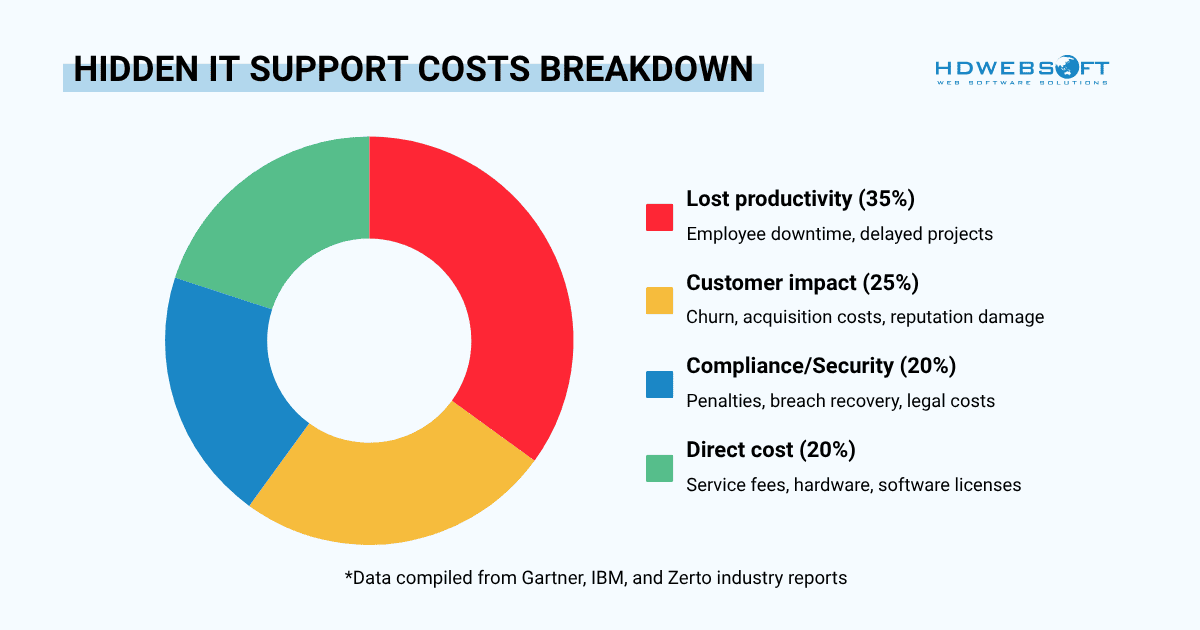
How Poor IT Support Costs Impact Customer Experience
The connection between IT downtime costs and customer satisfaction runs deeper than most organizations realize. In 2025’s hyperconnected marketplace, technical performance directly correlates with customer loyalty and business growth potential.
The Customer Experience Chain Reaction
Website performance issues trigger immediate customer abandonment, with studies showing that even one-second delays in page loading can reduce conversions by 7%. Consequently, businesses experience compound losses as poor IT support ROI decisions cascade through every customer interaction.
Transaction failures during checkout processes create particularly damaging experiences, often resulting in permanent customer loss rather than delayed purchases. Meanwhile, communication breakdowns prevent customer service teams from accessing critical account information, further frustrating already affected customers.
Modern Customer Expectations in the Digital Age
Today’s customers expect seamless digital experiences comparable to industry leaders like Amazon and Netflix. In fact, 55% of office workers report that ongoing tech issues negatively impact their mood, engagement, and long-term job satisfaction. So, the number highlights how technical problems affect not just external customers but internal team morale as well.
Moreover, hidden IT support costs have become a customer retention strategy rather than merely an operational expense. Instant switching behavior has become the norm, with customers readily abandoning brands that fail to meet technical performance standards.
Quantifying Customer Experience Costs
Customer lifetime value calculations reveal the true impact of technical failures. Losing a customer due to poor system performance can cost businesses between $10,000 and $100,000 in future revenue. It’s worth noting that it depends on the industry and customer segment.

In addition, customer acquisition costs continue rising across all industries, making retention through reliable technical performance increasingly valuable. Thus, companies must invest significantly more in marketing and sales technology to replace customers lost due to preventable technical issues.
Optimizing Business IT Strategy with Modern Support Models
Business IT strategy approaches have undergone a dramatic transformation. This is because organizations recognize that traditional reactive support models create more problems than they solve. Modern businesses require proactive, technology-enhanced support strategies that prevent issues rather than simply responding to them.
Moving Beyond Reactive Break-Fix Models
Traditional break-fix approaches wait for problems to occur before taking action. Inevitably, it results in higher hidden IT support costs and business disruption. Conversely, proactive monitoring identifies potential issues before they impact operations, dramatically reducing both downtime frequency and severity.
Predictive analytics now enable support teams to anticipate equipment failures, software conflicts, and capacity limitations weeks or months in advance. This approach transforms IT support ROI calculations by eliminating emergency repairs and minimizing business interruption.
Hybrid Support Models Gaining Market Traction
Modern business IT strategy increasingly favors hybrid approaches that combine on-site technical expertise with remote monitoring and support capabilities. This model provides immediate response for critical issues while maintaining cost-effective remote support for routine maintenance and troubleshooting.
Here’s a table of comparison so you’ll get to compare different approaches systematically:
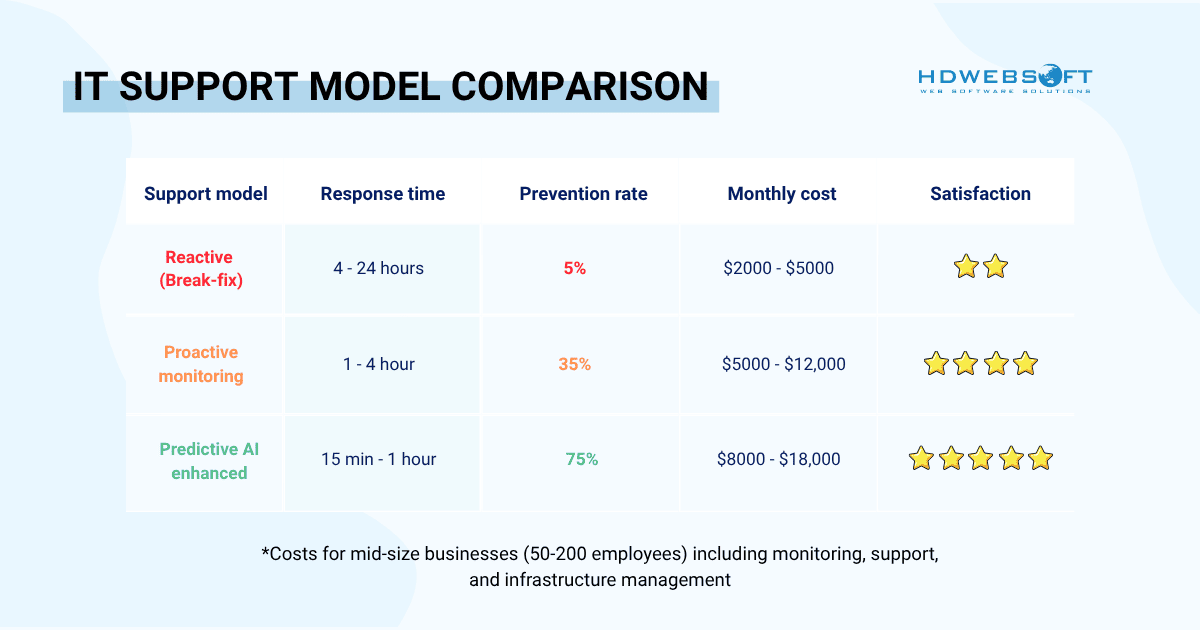
Notably, follow-the-sun support models offer 24/7 coverage without the premium costs associated with local after-hours support. Nearshoring enables international support teams to monitor systems and resolve issues within similar time zones. This ensures business continuity while optimizing hidden IT support costs through faster response times and improved collaboration
Technology-Enhanced Support Strategies
Nowadays, AI-powered monitoring systems are revolutionizing how organizations approach IT downtime costs. They provide real-time insights into system performance and automatically resolve routine issues without human intervention. These systems can identify patterns, predict failures, and often implement fixes before users notice problems.
In addition, cloud-native architectures reduce single points of failure while providing built-in redundancy and disaster recovery capabilities. This approach improves IT support ROI by minimizing the infrastructure complexity that traditionally drives support costs.
Mobile-responsive support platforms enable technicians to diagnose and resolve many issues remotely, reducing on-site visit requirements and associated travel costs. Self-service integration empowers users to resolve common problems independently, reducing ticket volume while improving satisfaction.
Calculating IT Support ROI: The Business Case for Investment
Smart organizations approach these calculations strategically. They’ve recognized that higher support investment often yields exponential returns through improved reliability and performance.
Comprehensive Cost-Benefit Framework
Investment categories for modern IT support costs include technology infrastructure, support team costs or outsourcing expenses, training programs, and monitoring tools. However, the benefits extend far beyond simple cost avoidance.
Thus, IT support ROI calculations must account for downtime reduction, productivity gains, customer retention improvements, and security practices for enhancement. These factors often provide returns that justify significant increases in support investment.
Quantifiable Benefits That Impact Bottom Line
Downtime reduction delivers immediate measurable value. Companies that reduce monthly downtime from 20 hours to 3 hours can save hundreds of thousands of dollars annually. Though you need to note that it depends on their business model and revenue structure.
Plus, productivity gains multiply across the organization when employees can focus on revenue-generating activities rather than dealing with technical problems. Faster issue resolution creates more productive workdays, which in turn leads to improved employee satisfaction and better overall business performance.
Customer retention also improves, providing long-term value that often exceeds annual IT support costs. Reducing customer churn by even 5% can increase profitability by 95%.
Sample ROI Calculation Scenario
Consider a mid-size company spending $10,000 monthly on basic IT support versus $18,000 on comprehensive proactive support. The additional $8,000 monthly investment ($96,000 annually) typically yields:
- Downtime reduction from 20 hours to 3 hours monthly saves approximately $200,000 in lost productivity.
- Improved customer experience reduces churn by 10%, retaining $150,000 in annual customer lifetime value.
- Enhanced security prevents potential breaches, avoiding average costs of $4.45 million per incident.
- Employee productivity improvements save 100 hours monthly across the organization.
This scenario demonstrates how IT support ROI can exceed 400% when accounting for all business impact factors rather than focusing solely on direct technical costs.
We’ve visualized the ROI argument with our specific example, check it out:
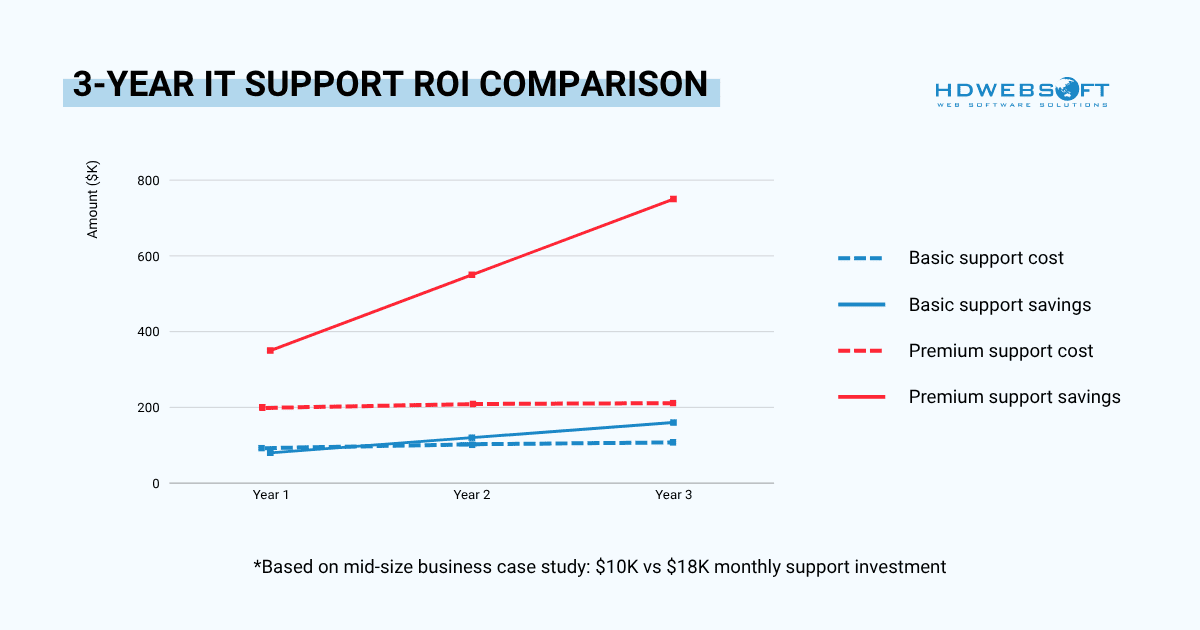
Reducing IT Downtime Costs Through Strategic Planning
As businesses recognize the true scope of hidden IT support costs, many are fundamentally restructuring their technology support strategies. This transition requires careful planning, strategic vendor selection, and clear success metrics to ensure optimal business IT strategy implementation.
Comprehensive Assessment Framework
Current state audits reveal hidden costs and identify improvement opportunities that justify increased support investment. Organizations must examine not only direct IT downtime costs. They should also consider customer satisfaction scores, employee productivity metrics, and competitive positioning relative to technology performance.
Future needs projection becomes critical as businesses scale and technology requirements evolve. IT support ROI calculations must account for growth trajectories and changing business and software development models that will impact support requirements over time.
Strategic Implementation Approaches
Phased implementation minimizes business disruption while allowing organizations to measure improvement incrementally. Starting with critical systems and gradually expanding coverage ensures smooth transitions while building internal confidence in new support models.
Vendor evaluation criteria extend beyond hidden IT support costs to include expertise depth, cultural alignment, scalability potential, and track record with similar organizations. After all, business IT strategy success depends heavily on choosing partners who understand specific industry requirements and growth objectives.
Measuring Success and Continuous Improvement
Technical metrics like uptime percentages, response times, and resolution speeds provide baseline measurements for IT downtime costs. However, business metrics, including customer satisfaction, employee productivity, and time-to-market improvements, offer more meaningful success indicators.
Conclusion
The evidence overwhelmingly demonstrates that IT support ROI represents far more than line items on operational budgets. Organizations that continue viewing technology support as a necessary evil will find themselves at significant competitive disadvantages in 2025.
Ultimately, the most successful organizations in 2025 will recognize IT support as a business growth enabler rather than merely a cost center. As a result, they will position themselves for sustainable competitive advantage through superior technology performance and customer experience.










